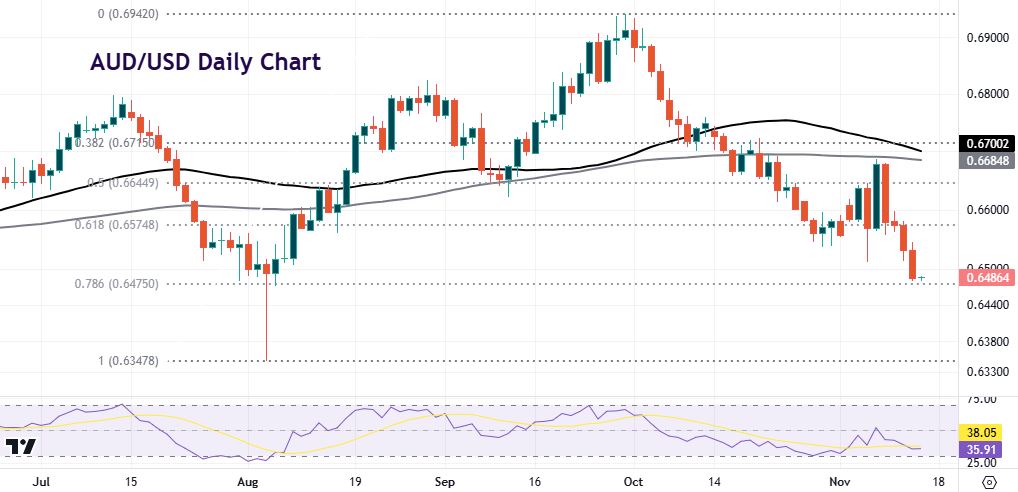Choppy day but USD keeps moving higher

* Bets on Fed December rate cut rise after US CPI data
* Dollar advances to near 7-month high, EUR/USD tumbles to new YTD lows
* Stocks closed mixed as Nasdaq falls, S&P 500 finishes flat
* Bitcoin surges to new record at $93,495 before pulling back
FX: USD surged higher for a fourth straight day, taking the buck up to April’s year-to-date highs at 106.51. The next upside target is 107.34, last year’s peak. US CPI printed in line, which was a mild relief to rates markets who reeled in bets on a pause in policy by the Fed next month. A 60/40 chance of a cut/pause before the data is now more like 80/20.
EUR carried on lower to levels last seen almost a year ago. Prices are not yet oversold and took out the April low at 1.0603. Protectionism and also geopolitical risk premium continue to drive the euro down as interest rate differentials widen further. Next near-term level is 1.0516.
GBP built on its recent breakdown closing around 1.27. MPC member Mann, a known arch hawk, couldn’t stem the tide. She warned that inflation “has definitely not been vanquished”. UK gilt yields followed US treasury yields higher. This is aggravating concerns on whether the Labour government’s new heavy spending ambitions are going too far and could spark further volatility in the gilt market. UK GDP is up next and not expected to lift the pound.
JPY finally broke higher above resistance and last week’s highs at 154.69/70. The US 10-year Treasury yield rose up near to recent highs. That helped the major with widening rate differentials between Japan and the US.
AUD sunk below the US election low at 0.6511. next stop is a Fib level at 0.6475 which is close to the July low. The overnight wage price index for Q3 was slightly cooler than expected. USD/CAD surged through prior resistance at 1.3946 to a top at 1.4002. That’s the highest since 2020.
US Stocks closed mixed with little changes in the major indices. The S&P 500 settled 0.02% higher at 5,985. The tech-heavy Nasdaq 100 lost 0.16% to finish at 21,0361. The Dow finished up 0.11% at 43,958. The majority of sectors closed in the green with consumer discretionary and energy outperforming. But communication and tech lagged, limiting the gains in the broader indices.
Asian stocks: Futures are mixed. Asian stocks mostly muted after the downbeat lead from Wall Street. The ASX 200 saw miners push the index lower. The Nikkei 225 pulled back, but losses were curtailed by more yen weakness. The Hang Seng and Shanghai Composite were mixed as concerns are mounting over Trump’s potential hawkish appointments, raising fears of increased tariffs. That said, Elon Musk has generally been China-friendly.
Gold dropped for fourth straight day. Near term (likely temporary) headwinds post US election include lower ETF demand as US equities and crypto re-rate higher. Futures positioning coming off historically high levels, alongside a stronger USD are also hurting bugs. The next downside level is the 50% mark of the June to October move at $2533 and the 100-day SMA at $2537.
Day Ahead – Australia Jobs
Following a very strong employment gain (+64k) in September, consensus expects the October employment gain to print at 20k. This would leave the three-month average run rate at 42k jobs a month, which is still strong jobs growth. The participation rate is forecast to fall back from the all-time high it reached in September. That means the unemployment rate should edge higher to 4.2%.
Monthly numbers are typically volatile, and results can often surprise. For the past six months, the employment figures have stunned the market to the upside. But the final quarter of the year is usually softer for population growth. That likely means a slower pace of job growth than recently seen.
Chart of the Day – AUD/USD sinks to support
This month so far, the aussie is actually outperforming all of the other currency majors versus the dollar apart from the loonie. That is because the RBA remains one of the hawkish outliers amongst central banks. The central bank recently kept its policy rate unchanged at 4.35%. Underlying inflation (3.5% Y/Y in Q3 2024) remains too high and isn’t expected to sustainably return to the midpoint of the 2-3% inflation target range until 2026. That means the first rate cut isn’t fully priced in until the second half of next year.
We are close to the minor Fib level (78.6%) of the August move up to September highs at 0.6475. After this is the August spike low at 0.6347. Prices would need to get up above the 61.8% retracement level at 0.6574 to slow the downtrend.

